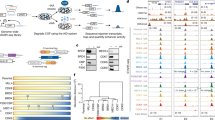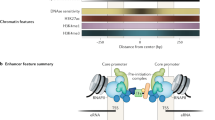Abstract
Both the human and the mouse bax promoters contain p53 binding sites which are sufficient to confer p53-dependent transcriptional activation in a heterologous setting. Nevertheless in the context of the bax promoter, these sites do not mediate a p53-dependent response, suggesting that bax may not be a direct transcriptional target of p53. Here, data are presented identifying a conserved p53 response element in the first intron of both the human and the murine bax genes. This element both in isolation and in the context of the first intron conferred p53-dependent transcriptional activation upon a minimal promoter. Electrophoretic mobility shift assays demonstrated that this sequence also is capable of mediating sequence specific binding to p53. p53 effectively activated transcription through both human and murine bax gene reporter constructs, whereas deletion of the intronic response element abrogated the p53-responsiveness of both reporters. Interestingly, tumor-derived mutants of p53 which are defective in inducing an apoptotic response retain the ability to activate transcription via the bax intronic p53 site. Since these mutants are transcriptionally inactive on the p53 site in the bax promoter, the ability of these mutants to up-regulating endogenous bax mRNA levels supports a role for the intronic element in p53-dependent up-regulation of bax expression. Taken together, these results show the requirement for a novel intronic element in the p53-dependent transcriptional activation of bax, and demonstrate that bax is indeed a direct and evolutionarily conserved transcriptional target of p53
This is a preview of subscription content, access via your institution
Access options
Subscribe to this journal
Receive 50 print issues and online access
$259.00 per year
only $5.18 per issue
Buy this article
- Purchase on Springer Link
- Instant access to full article PDF
Prices may be subject to local taxes which are calculated during checkout







Similar content being viewed by others
References
Baker SJ, Markowitz S, Fearon ER, Willson JK, Vogelstein B . 1990 Science 249: 912–915
Bargonetti J, Manfredi JJ, Chen X, Marshak DR, Prives C . 1993 Genes Dev. 7: 2565–2574
Bouvard V, Zaitchouk T, Vacher M, Duthu A, Canivet M, Choisy-Rossi C, Nieruchalski M, May E . 2000 Oncogene 19: 649–660
el-Deiry WS, Kern SE, Pietenpol JA, Kinzler KW, Vogelstein B . 1992 Nat. Genet. 1: 45–49
Fields S, Jang SK . 1990 Science 249: 1046–1049
Funk WD, Pak DT, Karas RH, Wright WE, Shay JW . 1992 Mol. Cell. Biol. 12: 2866–2871
Igata E, Inoue T, Ohtani-Fujita N, Sowa Y, Tsujimoto Y, Sakai T . 1999 Gene 238: 407–415
Jurgensmeier JM, Xie Z, Deveraux Q, Ellerby L, Bredesen D, Reed JC . 1998 Proc. Natl. Acad. Sci. USA 95: 4997–5002
Kim CN, Wang X, Huang Y, Ibrado AM, Liu L, Fang G, Bhalla K . 1997 Cancer Res. 57: 3115–3120
Knudson CM, Tung KS, Tourtellotte WG, Brown GA, Korsmeyer SJ . 1995 Science 270: 96–99
Lindsten T, Ross AJ, King A, Zong W, Rathmell JC, Shiels HA, Ulrich E, Waymire KG, Mahar P, Frauwirth K, Chen Y, Wei M, Eng VM, Adelman DM, Simon MC, Ma A, Golden JA, Evan G, Korsmeyer SJ, MacGregor GR, Thompson CB . 2000 Mol. Cell. 6: 1389–1399
Ludwig RL, Bates S, Vousden KH . 1996 Mol. Cell. Biol. 16: 4952–4960
Manon S, Chaudhuri B, Guerin M . 1997 FEBS Lett. 415: 29–32
McCurrach ME, Connor TM, Knudson CM, Korsmeyer SJ, Lowe SW . 1997 Proc. Natl. Acad. Sci. USA 94: 2345–2349
Miyashita T, Krajewski S, Krajewska M, Wang HG, Lin HK, Liebermann DA, Hoffman B, Reed JC . 1994 Oncogene 9: 1799–1805
Miyashita T, Reed JC . 1995 Cell 80: 293–299
Oltvai ZN, Milliman CL, Korsmeyer SJ . 1993 Cell 74: 609–619
Pastorino JG, Chen ST, Tafani M, Snyder JW, Farber JL . 1998 J. Biol. Chem. 273: 7770–7775
Pavletich NP, Chambers KA, Pabo CO . 1993 Genes Dev. 7: 2556–2564
Pietenpol JA, Tokino T, Thiagalingam S, el-Deiry WS, Kinzler KW, Vogelstein B . 1994 Proc. Natl. Acad. Sci. USA 91: 1998–2002
Resnick-Silverman L, St Clair S, Maurer M, Zhao K, Manfredi JJ . 1998 Genes Dev. 12: 2102–2107
Schmidt T, Korner K, Karsunky H, Korsmeyer S, Muller R, Moroy T . 1999 Cell Death Differ. 6: 873–882
Skulachev VP . 1998 FEBS Lett. 423: 275–280
Thornborrow EC, Manfredi JJ . 1999 J. Biol. Chem. 274: 33747–33756
Thornborrow EC, Manfredi JJ . 2001 J. Biol. Chem. 276: 15598–15608
Wang Y, Reed M, Wang P, Stenger JE, Mayr G, Anderson ME, Schwedes JF, Tegtmeyer P . 1993 Genes Dev. 7: 2575–2586
Wei MC, Zong WX, Cheng EH, Lindsten T, Panoutsakopoulou V, Ross AJ, Roth KA, MacGregor GR, Thompson CB, Korsmeyer SJ . 2001 Science 292: 727–730
Yin C, Knudson CM, Korsmeyer SJ, Van Dyke T . 1997 Nature 385: 637–640
Zhang L, Yu J, Park BH, Kinzler KW, Vogelstein B . 2000 Science 290: 989–992
Acknowledgements
We thank Bert Vogelstein (Johns Hopkins University) for the wild-type p53 expression plasmid and Karen Vousden (National Cancer Institute) for the 181L and 175P mutant p53 expression plasmids. Ron Magnusson is thanked for help with the recombinant baculovirus infections. Lois Resnick-Silverman is thanked for her help and support. This work was supported by grants from the National Cancer Institute (CA69161), the Breast Cancer Program of the US Army Medical Research and Materiel Command (DAMD-17-97-1-7336, DAMD-17-97-1-7337, and DAMD-17-99-1-9308), and the Peter J Sharp Foundation.
Author information
Authors and Affiliations
Corresponding author
Additional information
Accession number
The Genbank accession #s are: AF339054 and AF339055.
Rights and permissions
About this article
Cite this article
Thornborrow, E., Patel, S., Mastropietro, A. et al. A conserved intronic response element mediates direct p53-dependent transcriptional activation of both the human and murine bax genes. Oncogene 21, 990–999 (2002). https://doi.org/10.1038/sj.onc.1205069
Received:
Revised:
Accepted:
Published:
Issue Date:
DOI: https://doi.org/10.1038/sj.onc.1205069
Keywords
This article is cited by
-
Ethyl acetate extract of Elephantopus mollis Kunth induces apoptosis in human gastric cancer cells
BMC Complementary Medicine and Therapies (2021)
-
How does p53 induce apoptosis and how does this relate to p53-mediated tumour suppression?
Cell Death & Differentiation (2018)
-
Census and evaluation of p53 target genes
Oncogene (2017)
-
ERK mediated upregulation of death receptor 5 overcomes the lack of p53 functionality in the diaminothiazole DAT1 induced apoptosis in colon cancer models: efficiency of DAT1 in Ras-Raf mutated cells
Molecular Cancer (2016)
-
Regulatory non-coding RNA: new instruments in the orchestration of cell death
Cell Death & Disease (2016)



